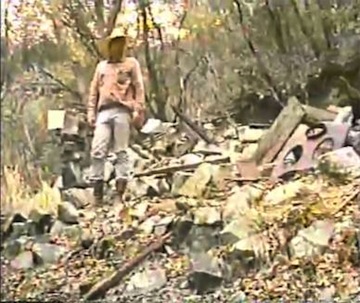Entertainment Magazine
Treasures of the Santa Catalina Mountains
The Lost City of the Santa Catalina Mountains
By Robert Zucker
The stone wall remaining among several partial structures hidden deep in the Santa Catalina Mountains. Photo by Fint Carter.
Hidden among heavy brush in the heart of the
Santa Catalina Mountains– near the Reef of Rock and Cañada del Oro
river– is another fertile area that has signs of previous human
activity. It is unknown how long this area has been inhabited.
This part of the Cañada del Oro canyon, just north of Mt. Lemmon
and Sumerhaven, was active at the turn of the 20th Century with
numerous mining operations. It remained quiet for decades until a group
of prospectors, professionals and community leaders went into the deep
brush and trees to check out reports of a lost city site, somewhere near
Marble Peak.
At this remote location, there is evidence of human inhabitation
and mining production–scattered stone ruins, some artifacts, mineshafts
and debris.
In 1978, Tommy Thompson, president of the Oracle Historical
Society, along with Thomas Perry, a film producer, prospector William
“Flint” Carter, and six others drove to Catalina Camp. They proceeded on
foot to the Reef of Rock in search of the legendary Lost City once
again. They found evidence of old stoves, possibly from the 1880s, but
not the fabled Lost City.
The lost city site was finally discovered when Carter, with
another group, found the ruins near Catalina Camp in 1985. They didn’t
think it was much because they only found a few old stone foundations
and walls. It was anti-climatic. But, it seemed someone was there
earlier with a bulldozer, pushed material over the hill and destroyed
any other evidence of the city.
The “ninja crew,” as they called themselves, staked mining
claims in the area in 1990. Within the corner of one of the buildings,
Rich Wong, Dean Chambers, Joseph Wilson and Carter found what they
believed was the legendary hatchet that the miners used to carve the
gold out of the mountain. The item was turned over to the U.S. Forest
Service.
The lost city ruins site deserved further examination. An
Archaeological and Historical Site Inventory conducted by the U.S.
Forest Service found evidence of at least three, possibly four,
multi-room rock wall structures with collapsed roofs. Carter’s Claim is
still in possession of Carter & Co. through federal mining claims.
Glass bottle fragments (some were purple and some were clear),
tin cans and a pocket tobacco tin (marked “Twin Oaks”) were among some
of the artifacts collected. The purple glass and hole-in-cap tin can
indicated the site was used before the 1920s. Activity of a former
mining camp was nearby. A systematic survey was not done so other
cultural materials may be uncovered, the report indicated.

Photo of Flint Carter at the Lost City rubble in the Santa Catalina Mountains.
Since 1873 through the late 1950s, the areas
near the Reef of Rock and Oracle Ridge has been steadily mined.
Pioneers Emerson O. Stratton, Robert Leatherwood, and a generation
later, Francis Hartman, made dozens of claims around the mountaintops
and valleys along the Oracle Ridge. Production records are minimal, but
with the restart of the Oracle Ridge Mine recently, there still are
enough minerals to make the investment worthwhile after 140 years of
American mining production.
During another expedition in 1995, one of the members of
Carter’s group included George Mroczkowski, author of the “Professional
Treasure Hunter,” found an 1812 Mexican coin in front of a caved-in
tunnel. Carter staked a claim and got a permit to open the tunnel. But
after four years of extensive digging, it turned out to be just a
30-foot exploratory tunnel from sometime at the turn of the century.
Drill holes were found at the end of the tunnel. Several additional
quests were conducted over the years with varying results. A recent
expedition in the spring of 2014 with a geologist and crew revealed
additional structures and evidence not observed earlier.
The area near the Reef of Rock, in the interior of the Santa
Catalina Mountains, is far from the path, covered in brush and trees,
and not visible from the Arizona Trail.
Buy "Treasures of the Santa Catalina Mountains"
© 2015 Entertainment Magazine. All rights reserved.
|

